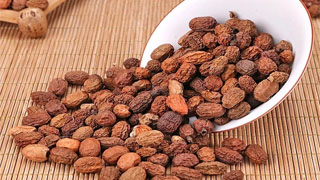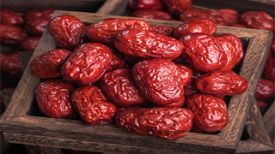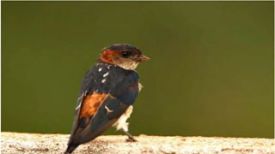
1. Alias
Red beans, red cardamom, ginger seeds, and red button.
2. Plant morphology
Perennial herb. The roots and stems are thick and robust. Two rows of leaves, with few stems; The leaves are narrow and elliptical in shape, with a sharp pointed tip and a short pointed tip. The base is wedge-shaped, and the leaf margin is thick and ciliated. The underside is sparsely hairy or hairless, and the tip of the leaf tongue is blunt. The inflorescence is terminal and the inflorescence axis is hairy; There are 3-6 flowers on each branch, with a tubular sepal and a 3-lobed tip with ciliated edges; The coronal tube and calyx tube are approximately equal in length, with 3 lobes, green white, oblong in shape, slightly wider lobes above, and a rounded apex; Lipstick is ovate to oblong in shape, white in color, slightly thickened in the middle, and has red stripes. There is one stamen, about the same length as the lip, and the anthers are oblong in shape. There is no stigma attached to the apex; The base of the lip has two degenerated stamens, lanceolate in shape; Ovary lower, 3-chamber, stigma slightly swollen, apex sunken, with margin hairs. The capsule is rectangular or oval in shape, slightly contracted in the middle, and has a persistent calyx at the top. It is red when ripe. Seeds 3-6, polygonal, brownish black, covered with light brown membranous false seed coat. The flowering period is from June to July, and the fruiting period is from July to October.
3. Origin distribution
Born on hillsides, grasslands, and shrubs in the wilderness. Distributed in Guangdong, Hainan, Guangxi, Yunnan and other places.
4. Harvesting and processing
Harvest in autumn when the fruit turns red, remove impurities, and dry in the shade.
5. Characteristics of medicinal herbs
Long spherical shape, slightly thinner in the middle. The surface is reddish brown or dark red, slightly wrinkled, with a yellow white tubular calyx at the top and fruit stem marks at the base. The skin is thin and easily broken. The seeds are flattened or triangular polyhedral, black brown or reddish brown in color, covered with a yellow white membranous pseudocarp, and the endosperm is gray white. It has a fragrant aroma and a spicy taste.
6. Sexual Taste Returning to the Classics
Warm in nature, pungent in taste. Return to the lung meridian and spleen meridian.
7. Effect and Function
Dry and damp, dispel cold, invigorate the spleen, and digest food. Belonging to Wenli medicine.
8. Clinical application
Take 3-6 grams and decoct; Or for external use. Used to treat cold pain in the epigastric region, bloating caused by food accumulation, vomiting and diarrhea, and excessive alcohol consumption. Red cardamom as the powder, slightly twitching the nose left and right, and adding saliva or musk to the teeth to treat wind cold toothache ("Hygiene Home Treasure Formula").
9. Pharmacological research
Anti ulcer; Resistance to pathogenic microorganisms; Anti tumor. Acetic acid 1 '- acetoxy piperonyl ester and acetic acid 1' - acetoxy eugenol ester have anti ulcer effects; Acetic acid l '- acetoxy piperonyl ester has significant antibacterial activity against skin fungi such as Trichophyton rubrum and Trichophyton rubrum. In addition, it also has expectorant and anti-cancer effects.
10. Chemical composition
Containing volatile oils, flavonoids, saponins, and fatty acids. It also contains 1 '- acetoxypiperonyl acetate, 1' - acetoxyeugenol acetate, eugenol epoxide, racemic 1-acetoxypiperonyl acetate, trans 3,4-dimethoxycinnamyl alcohol, 1,8-eucalyptol, allocineole, linalool, orange blossom tertiary alcohol, citronellol, cardamom aldehyde methyl, red cardamom aldehyde ethyl, etc.
11. Usage taboos
Those with yin deficiency and heat should avoid taking it.
12. Compatibility prescription
① Treatment of epigastric pain (including chronic gastritis and neuropathic stomach pain): 3g of red cardamom. At the end of the study, take 1 gram of brown sugar soup and take it 3 times a day. Food, Traditional Chinese Medicine, and Toilet Formulas
② Treatment for gastric and duodenal ulcers: 9 grams each of red cardamom, forsythia suspensa, and chicken inner gold, and 4.5 grams of Huanglian. Boil it in water. (Selected Chinese Herbal Formulas)
③ To treat wind cold toothache: Use red cardamom powder and gently twist it into the nose on both sides, then mix it with teeth to take saliva or add musk. (Hygiene Treasure Formula)
④ To treat chronic bronchitis and cough up phlegm, take 3g of red cardamom, 6g each of radish and perilla seeds, decoct in water, and take twice a day. (Food, Traditional Chinese Medicine, and Toilet Formula)
⊙ The content of the article is for clinical reference only. Non TCM professionals are not allowed to test drugs.


